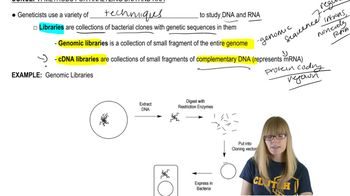Table of contents
- 1. Introduction to Genetics51m
- 2. Mendel's Laws of Inheritance3h 37m
- 3. Extensions to Mendelian Inheritance2h 41m
- 4. Genetic Mapping and Linkage2h 28m
- 5. Genetics of Bacteria and Viruses1h 21m
- 6. Chromosomal Variation1h 48m
- 7. DNA and Chromosome Structure56m
- 8. DNA Replication1h 10m
- 9. Mitosis and Meiosis1h 34m
- 10. Transcription1h 0m
- 11. Translation58m
- 12. Gene Regulation in Prokaryotes1h 19m
- 13. Gene Regulation in Eukaryotes44m
- 14. Genetic Control of Development44m
- 15. Genomes and Genomics1h 50m
- 16. Transposable Elements47m
- 17. Mutation, Repair, and Recombination1h 6m
- 18. Molecular Genetic Tools19m
- 19. Cancer Genetics29m
- 20. Quantitative Genetics1h 26m
- 21. Population Genetics50m
- 22. Evolutionary Genetics29m
18. Molecular Genetic Tools
Methods for Analyzing DNA
Problem 26
Textbook Question
In Drosophila, loss-of-function Ultrabithorax mutations result in the posterior thoracic segments differentiating into body parts with an identity normally found in the anterior thoracic segments. When the Ultrabithorax gene was cloned, it was shown to encode a transcription factor and to be expressed only in the posterior region of the thorax. Thus, Ultrabithorax acts to specify the identity of the posterior thoracic segments. Similar genes were soon discovered in other animals, including mice and humans. You have found that mice possess two closely related genes, Hoxa7 and Hoxb4, which are orthologs (see Genetic Analysis 14.2 for definition) of Ultrabithorax. You wish to know whether the two mouse genes act to specify the identity of body segments in mice. How will you determine where and when the mouse genes are expressed?
 Verified step by step guidance
Verified step by step guidance1
Step 1: Use in situ hybridization to detect the spatial expression patterns of Hoxa7 and Hoxb4 in mouse embryos. This technique will allow you to visualize where these genes are being transcribed in the developing tissues.
Step 2: Perform reverse transcription polymerase chain reaction (RT-PCR) on RNA extracted from different embryonic stages and tissues to determine the temporal expression patterns of Hoxa7 and Hoxb4. This will help you understand when these genes are active during development.
Step 3: Utilize reporter gene assays by creating transgenic mice that express a reporter gene, such as GFP, under the control of the Hoxa7 and Hoxb4 promoters. This will provide a visual representation of gene expression in live tissues.
Step 4: Conduct immunohistochemistry using antibodies specific to the proteins encoded by Hoxa7 and Hoxb4. This will help you determine the localization of the proteins within the cells and tissues.
Step 5: Compare the expression patterns of Hoxa7 and Hoxb4 with known markers of body segment identity to assess whether these genes are involved in specifying segmental identity in mice.
Recommended similar problem, with video answer:
 Verified Solution
Verified SolutionThis video solution was recommended by our tutors as helpful for the problem above
Video duration:
4mPlay a video:
Was this helpful?
Key Concepts
Here are the essential concepts you must grasp in order to answer the question correctly.
Gene Expression
Gene expression refers to the process by which information from a gene is used to synthesize functional gene products, typically proteins. Understanding when and where a gene is expressed is crucial for determining its role in development and function. Techniques such as in situ hybridization and quantitative PCR can be employed to analyze gene expression patterns in specific tissues or developmental stages.
Recommended video:
Guided course

Penetrance and Expressivity
Transcription Factors
Transcription factors are proteins that bind to specific DNA sequences to regulate the transcription of genes. They play a critical role in determining the identity of body segments by activating or repressing the expression of target genes. The Ultrabithorax gene, for example, encodes a transcription factor that specifies posterior thoracic segment identity in Drosophila, highlighting the importance of these proteins in developmental biology.
Recommended video:
Guided course

Eukaryotic Transcription
Orthologs
Orthologs are genes in different species that evolved from a common ancestral gene and typically retain the same function. The identification of Hoxa7 and Hoxb4 as orthologs of Ultrabithorax suggests that similar genetic mechanisms may govern body segment identity across species. Studying orthologs can provide insights into evolutionary conservation and the functional roles of genes in development.
Recommended video:
Guided course

Overview

 7:40m
7:40mWatch next
Master Methods for Analyzing DNA and RNA with a bite sized video explanation from Kylia Goodner
Start learningRelated Videos
Related Practice


